Introduction
Fishponds are one of the common agricultural containers in rural communities1. In a fish pond, there are many life activities that come from fish, moss, and other microorganisms2. In one of the provinces in Indonesia, West Sumatra Province, to be precise, there are groups of people who try to use fish ponds as a place to store fresh ground chilies. Based on the observations that have been made directly in the field, it is known that the condition of ground chilies stored in plastic and then placed in a pond for one month is approximately the same as ground chilies stored in the refrigerator. Something different happens when fresh ground chilies are only placed in ambient conditions; then, the fresh ground chili will rot in just 2-3 days. Due to the high-water content, ground chili decomposes quickly when stored in an ambient environment. Water activity AW is essential for the growth of microbes like bacteria and fungi. Primary metabolites in the material, such as carbohydrates, are employed as a substrate in the fermentation process throughout this growth process to form organic acids, which serve as a sign that the item is rotting.
Ground chili is one of the many diversifications of fresh chili products in West Sumatra. The ground chili is attempting to make it more practical in use. Consumers no longer need to grind fresh chilies before cooking. The ground chili is widely used for dishes with this type of curry. In addition, the product’s shelf life is also increased by making fresh chilies into ground chilies3. This is due to the difference in postharvest’s mechanism when the chili is in a fresh condition compared to ground ones. When it’s still fresh, the respiration process still occurs, so the senescence and decay process can occur very quickly because the respiration rate of chili is high. Turning chili into ground chili will indirectly stop the respiration process so that the preservation process in chili will change4. In general, the control process for fresh ground chilies focuses on controlling the growth of microorganisms due to the high water content in the ground chilies.
In the community, especially sellers, ground chili can be stored in the refrigerator. The use of cold temperatures in the refrigerator can inhibit the occurrence of spoilage due to active microorganisms. However, as in the community, surveillance has occurred when fresh ground chilies are stored in fish ponds. This phenomenon is still very novel and there is no explanation for it. The hypothesis regarding the same cold temperature conditions as the refrigerator does not seem to apply to fish ponds5. Fish ponds outside the room that can be exposed to direct sunlight will make the fish pond temperature less cold than the refrigerator. Moreover, fish ponds are located in the territory of Indonesia with a tropical climate. This study will study the changes in metabolites that occur when a fresh chili product is stored in a pond and compared with storage in a refrigerator. Although the naked eye knows that the quality of fresh ground chili stored in fish ponds and refrigerators is relatively the same, whether the metabolites contained in it will also be the same5. A previous study indicated that the sensorial and proximate indicators such as water content, pH, vitamin C and colour of ground chilies stored in the fish pond was similar as that of ground chilies stored in the refrigerator. However, there was no observation for specific metabolites that could explain the mechanism of preservation. In general, the fermentation process during decay is related to the decrement of carbohydrate and protein as the substrates, therefore, in this study the observation on these metabolites were focused.
This study’s results will help explain the mechanism of preservation of fresh ground chili that occurs in fish ponds. Suppose the metabolite profiles in ground chilies stored in fish ponds and refrigerators are the same. In that case, it can be hypothesized that suppression of enzymatic activity also occurs when ground chilies are stored in ponds. It is necessary to find out what causes enzymatic activity to be suppressed apart from the influence of temperature4,6. This finding will be significant for making this fish pond storage technique more widely because this technique is environmentally friendly and does not use electricity.
Material and Methods
Study area
The experiment was conducted from July 2022 to June 2023. The study was conducted at a fish pond in the local farm, in Padang City, West Sumatra Province, Laboratory of Phytonutrient Departmen of Food and Agricultural Product Technology Andalas University and Laboratory Food Distribution Engineering Gifu University.
Sample Preparation
Local farmers provided fresh red chilies (kuhay variety) for this research. Red chilies were immediately sorted and mashed for preparation for the subsequent study. A plastic bag with a low-density polyethylene (LDPE) clip was filled with approximately 100 grams of ground chili, and then the sample was put into another plastic bag as outer packaging. The sample was stored in the fish pond to submerge in the liquid (Code F). To observe how the characteristics of the sample change over time, samples were taken periodically. The sampling was carried out for 0, 1, 2, and 4 weeks. The control treatment consisted of the use of storage in the refrigerator with temperature at ± 8 ºC (code: R). The temperature was set directly on the refrigerator and confirmed by put the manual mercury thermometer inside the refrigerator. The storage on ambient conditions (temperature at ± 26 ºC) was done only for microbial growth observation. The temperature was measured by put the manual mercury thermometer inside the fishpond. The experiments were conducted in triplicate.
Figure 1 illustrates fish pond storage carried out in this study. Fresh ground chilies were stored in an LDPE plastic bag and put into the water in the fish pond. Fish ponds are traditional ponds consisting of freshwater fish and some plants deliberately bred in the pond. In addition, the pond also contains fish feed residue. The sample was put in the middle of water inside the fish pond.
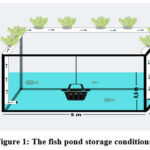 |
Figure 1: The fish pond storage conditions. |
Analytical parameters: The quality parameters of treated samples were focused on total plate count for microbial observation, amino acid and capsaicinoids profile by using Liquid Chromatography Mass Spectrometry Triple Quad (SCIEX 4500) and sugars by using High Performance Liquid Chromatography-Charged Aerosol Detector (HPLC-CAD Thermo-Ultimate 3000)7-12.
Total plate count measurement was conducted according to Rini7 with slight modification. 10 grams of sample was crushed, and after that, the refined sample was transferred to the Erlenmeyer in conjunction with 90 mL of sterile distilled water. The mixture was homogenized and covered in cotton. This preparation was used to create a 10-1dilution. The diluted material was used to create stratified dilutions. A 10-2 dilution was produced by homogenizing 1 mL of the suspension from the 10-1dilution in a tube with 9 mL of sterile, distilled water. Up to a dilution of 10-4, the dilution was made continually. From each sample, 1 mL of the suspension was collected and aseptically placed into a sterile petri dish. Plate Count Agar medium, which had been diluted, was put to each petri dish. Each petri dish was wrapped in paper before being incubated for 18 to 24 hours at 37 0C. To calculate the total number of plates, growing bacterial colonies were counted. A petri dish with a bacterial colony of 30–300 colonies can be used to calculate the number of bacterial colonies.
Amino acid was analyzed by using Multiple Reaction Monitoring (MRM) technique. The optimized MRM Transitions for Free Amino Acids was presented in table 1. A 50 mg of the sample were diluted in 0.1% formic acid in water for analysis. Methanol precipitation was used to remove the cell supernatant from purified peripheral blood mononuclear cells. In order to perform an LC MS/MS analysis, the supernatant was diluted 1 to 50 in water with 0.1% formic acid. Injection volume was 2 µL. The ionization was set with positive ESI. Amino acids were separated with ACE 3 AQ column (HiChrom), 0.5 x 150 mm; flow rate 20 µL/min. Mobile phases: 0.1% formic acid in water (A), 0.1% formic acid in acetonitrile (B). Gradient: 2 to 20% B over 5 minutes, total analysis time 10 minutes. All detected peaks were extracted and analyses with markerview software.
Table 1: MRM for amino acids
| Amino Acid | Q1 (m/z) | Q3 (m/z) |
| Glycine | 76.1 | 30 |
| L-Alanine | 90.1 | 44 |
| L-Serine | 106.1 | 60 |
| L-Proline | 116.1 | 70 |
| L-Valine | 118.1 | 55 |
| L-Threonine | 120.1 | 103.2 |
| L-Leucine/isoleucine | 132.1 | 86 |
| Isoleucine 2 | 132.1 | 69 |
| L-Aspartic Acid | 134.1 | 74 |
| L-Lysine | 147.1 | 84 |
| L-Glutamic Acid | 148.1 | 84 |
| L-Methionine | 150.2 | 104 |
| L-Histidine | 156.1 | 110 |
| L-Phenylalanine | 166.1 | 103 |
| L-Arginine | 175.2 | 70 |
| L-Tyrosine | 182.1 | 165.2 |
| L-Cystine | 241.2 | 152 |
The capsaicinoid was also analyses by using MRM technique. The optimized MRM Transitions for capsaicinoids was presented in table 2. A 50 mg sample was crushed using a rotary crusher in 200 µl aliquots of methanol that contained 0.05% BHT. Mixtures were homogenized after 400 µL aliquots of chloroform were added. The organic phases were collected and injected into the LC MS/MS as much as 5 µL. The capsaicinoids were separated with imtakt unison uk-c18 150 x3 mm column. The mobile phase consists of 1% formic acid in Acetonitrile (A) and 1% formic acid solution (B), the gradient program which was 0-1 min 50% A and 50 % B, 1-5 min 2% A and 98 % B, 3- 8 min 2% A and 98% B, 8-10 min 50% A and 50 % B and finally 10-15 min 50% A and 50% B. The ionization was set with positive ESI. The flow rate of the mobile phase was 0.35 mL/min. All detected peaks were extracted and analyses with markerview software.
Table 2: MRM for capsaicinoids.
| Capsaicinoids | Q1 (m/z) | Q3 (m/z) |
| Capsaicin | 306.2 | 136.9 |
| Dihydrocapsaicin | 308.2 | 136.9 |
Sugars was analyses by using using High Performance Liquid Chromatography-Charged Aerosol Detector. A 100 mg sample was added 5 mL of ethanol. The solution was the homogenized and centrifuged. The supernatant was then filtered and injected the chromatography system. Separation of sugars was performed in a Shodex Asahipak NH2P-50 4E, 5 μm (4.6 × 250 mm) column with precolumn Asahipak NHZP-506 4A. The mobile phase of the optimized method composed of (A) 75% acetonitrile and (B) 25% water. The flow rate was 1 mL/min. The column temperature was controlled at 30°C. The injection volume was 20 μL for standards and samples.
Statistical analysis
The SPSS package program, version 11.5 (SPSS Inc., Chicago, IL, USA), was used for statistical analysis. Results are presented as Mean±SD of samples collected in triplicate. At p ˂ 0.05, the difference was considered a significant treatment. Analysis of the principal component analysis was carried out using Marker view software from Sciex.
Result and Discussion
Figure 2 indicates the changes of total microbial on fresh ground chili stored in the refrigerator and the fish pond. An extremely similar increment of total microbial was observed in samples stored in both conditions for two weeks storage while a slight difference found after four weeks storage. The slope of microbial growth of refrigerator and fish pond storage were similar and that of was extremely different from the slope of microbial growth of ambient storage. These data indicated that the growth of microbes in ground chili occurred at the same rate when it’s stored in the refrigerator with low-temperature conditions and in the fish pond ambient temperature. Different pattern was observed when the fresh ground chili was stored without any treatment at ambient condition (at room temperature). A significant increment of microbial growth occurred start from the early week of storage.
It is known, a preservative effort for fresh food is defined as a condition that is capable of inhibiting, retarding or arresting the growth of microorganism. Low-temperature storage with refrigerator storage is one way to inhibit microbial growth due to the suppression of enzymatic activity13,14,15. However, at storage conditions in the fish pond with an ambient temperature of approximately at 26 ºC, the inhibition of microbial growth was not due to the suppression of enzymatic activity by low temperature as storage at cold temperatures in the refrigerator. There must be a condition that also suppresses enzymatic activity instead of low temperature.
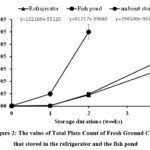 |
Figure 2: The value of Total Plate Count of Fresh Ground Chili that stored in the refrigerator and the fish pond |
The propensity for spoilage of fresh chilies stored in refrigerators and ponds was comparable, thus further experiments were limited to these storage settings. Figure 3 shows the sugar content on fresh ground chili stored in the refrigerator and the fish pond. Sugar is related to respiration since it reacts with oxygen to produce carbon dioxide and water16,17. It was hypothesized that respiration was not occurring on the stored ground chili because the ground chili is a processed food. From Figure 3, it can be noted that there were no changes in sugar content on both stored ground chilies in the refrigerator and the fish pond. The sugar detected in the ground chili was fructose, glucose, and sucrose, where fructose and glucose were the major compounds. From the result, it could be clarified that the storage conditions for ground chili will not affect the sugar content since respiration might not occurred. The low activity of microbial might also contribute to the stability of sugars. It is known that the damage to ground chilies during storage can be seen in the appearance of a sour aroma that may occur due to the fermentation of sugar by microbes. The decrement of sugar seemed to be happened on the fourth weeks. The fermentation process might have occurred at this time.
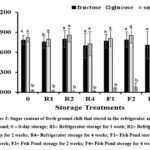 |
Figure 3: Sugar content of fresh ground chili that stored in the refrigerator and the fish pond; 0 = 0-day storage; R1= Refrigerator storage for 1 week; R2= Refrigerator storage for 2 weeks; |
Capsaicin is a group of capsaicinoids. This compound is indigenous to chili, which has a spicy taste and a distinctive smell. Apart from Capsaicin, other members of the Capsaicinoids are dihydrocapsaicin, Capsaicin, dihydrocapsaicin, norcapsaicin, homodihydrocapsaicin, homocapsaicin, and nonivamide. Traditionally, the spicy taste of chilies sometimes determines the quality of a chili product. Therefore, changes in capsaicin levels in chilies during storage need to be known. According to Figure 4, two capsaicinoids had been identified in treated chilies, i.e., Capsaicin and dihydrocapsaicin. Similar to the sugar profile, the trend of capsaicinoids were similar during storage in the refrigerator and the fish pond. Though the amount of capsaicinoids changed, statistically prespective, they did not vary significantly. It can be assumed that in both storage treatments, there were no adverse conditions that could affect capsaicinoid levels, such as light, oxidation, and heat18-20.
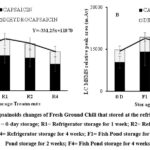 |
Figure 4: Capsainoids changes of Fresh Ground Chili that stored at the refrigerator and the |
Amino acids are essential macromolecules present in all living things, including microbes. They function as nutrients and regulate various biological processes in bacteria, including cell division, creation of cell walls, cell growth and metabolism, intracellular communication, and interactions between microbes and their hosts21. In other words, the presence of amino acids can affect the defense system against microorganisms22,23. In storing ground chilies, it has been hypothesized that microbial growth will be the leading cause of damage; therefore, this study also looked at changes in the amino acid content of fresh ground chilies.
In this study, the amino acids were analyzed by using LC MS/MS using MRM technique. Nineteen amino acids had been detected in treated samples (Fig S1). The large size of matrix distribution necessitates the use of principal component analysis (PCA) for statistical analysis. Figure 5 shows the PCA of amino acid distribution on ground chilies stored in the refrigerator and the fish pond. The PCA is typically carried out using plots called scores plots and loadings plots24,25. Scores plots show how the samples in the n initial observations relate to one another. A loadings plot demonstrates how the initial variables interact to create each primary component. This gives some information about how the initial variables relate to one another.
Based on PCA data, it can be concluded that amino acid changes during the storage of fresh ground chilies. The amnio acids were changed according to the storage time, both in stored condition at the refrigerator and the fish pond. However, the amino acid changes in the ground chili differed when stored in the fridge compared to the fish pond. This result is related to the hypothesis that the condition of low-temperature storage may induce a different reaction in the prevention of fresh ground chili compared to the ambient temperature of the fish pond storage. Although the temperature was approximately high in the fish pond storage, there must be a scientific reason that makes the microbial activity not massive. This explanation urgently needs to be found as soon as possible to form the basis of this important discovery. This discovery will have a significant impact on human life in the future
Figure 6 shows the loading plot of amino acids distribution that contribute for determining the differences in the schemes of the refrigerator and fish pond storage in Fig. 5. In brief, data indicated that the changes in leucine, valine, methionine, tyrosine, phenyl alanine and aspartic acid could be as the amino acids that was susceptible to be changed in fish pond storage compared to refrigerator storage. Gao26 had reported that mentioned amino acids above was proved to be the main limiting amino acids in chili that stored at high temperatures.
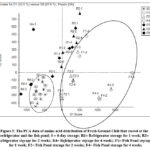 |
Figure 5: The PCA data of amino acid distribution of Fresh Ground Chili that stored at the refrigerator and the fish pond; 0 = 0-day storage; R1= Refrigerator storage for 1 week; R2= Refrigerator storage for 2 weeks; R4= Refrigerator storage for 4 weeks; |
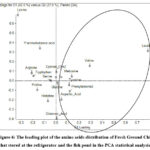 |
Figure 6: The loading plot of the amino acids distribution of Fresh Ground Chili that stored at the refrigerator and the fish pond in the PCA statistical analysis. |
Conclusion
It is known from this study that the trend of microbial growth, sugar, and capsaicinoid content of fresh ground chilies in the refrigerator and fish ponds were relatively the same. Moreover, it was also observed that there were differences in the amino acid profile. This finding was an interesting matter that can be explored further with a proteomics approach to provide conclusions about what phenomena makes storage in fish ponds maintain the quality of ground chili as well as storage in ponds. This study also shows that although sensorial, there was no difference between ground chilies stored in the refrigerator and fish ponds; microscopically, there might be differences.
Significance statement
This study revealed the potential use of a fish pond for the storage of freshly ground chili. These results can be used as baseline data for developing alternative non-refrigerated storage options. It is an environmentally friendly technology that useful in the future for a better life of human being.
Acknowledgments
The authors gratefully acknowledge the support of a research publication from Indonesian DRTPM with the scheme of Fundamental Research 2023. The authors also wishes to express the gratitude to the students who assisted them in conducting the research.
Conflict of Interest
There are no conflict of interest.
Funding Sources
The research was funded by DRTPM Directorate of Higher Education, Indonesian Ministry of Education, Culture, Research and Technology with no 115/E5/PG.02.00.PL/2023, Fiscal year 2023
References
- Pouil S, Samsudin R, Slembrouck J, Sihabuddin A, Sundari G, Khazaidan K, Kristanto A, Pantjara, B, Caruso D. (2019). Nutrient budgets in a small-scale freshwater fish pond system in Indonesia. Aquaculture. 504. 267-274. 10.1016/j.aquaculture.2019.01.067.
CrossRef - Haditomo A, Desrina, Sarjito S, Prayitno S. (2018). Probiotic Candidates from Fish Pond Water in Central Java Indonesia. IOP Conference Series: Earth and Environmental Science. 116. 012018. 10.1088/1755-1315/116/1/012018
CrossRef - Surya R, Tedjakusuma F. (2022). Diversity of sambals, traditional Indonesian chili pastes. Journal of Ethnic Foods. 9. 1-19. 10.1186/s42779-022-00142-7.
CrossRef - Hameed R, Malik A, Khan A, Imran, Umer M, Riaz, R. (2015). Evaluating the effect of different storage conditions on quality of green chillies (Capsicum annuum L.). Tropical Agricultural Research. 24. 391. 10.4038/tar.v24i4.8024.
CrossRef - Syukri D, Feri A, Fauzan A, Aisman, Jaswandi, Milda Y. (2022). Potential of storing fresh ground red chilies in water as a substitute for home refrigerators. Asian Journal of Sciences, 21(4), 735-739. DOI: 10.3923/ajps.2022.735.739
CrossRef - Draszanowska A, Karpińska-Tymoszczyk M, Olszewska M. (2020). Effect of the addition of chili peppers fruit and refrigerated storage time on the quality of pasteurized canned meat. Czech Journal of Food Sciences. 38. 10.17221/52/2020-CJFS.
CrossRef - Rini, Heru S, Purnama D H, Daimon S, Jaswandi, Fredy K, and Muhammad M. (2023). Application of Nanocellulose Biofilter from Pineapple Peel Waste for Water Microbes Removal, Journal of Environmental and Public Health, vol. 2023, Article ID 5823207, 6 pages, 2023. https://doi.org/10.1155/2023/5823207
CrossRef - Fauzan A, Tuty A, Daimon S, Ryan A S. (2017). Effects of Sodium Bisulfite Soaking on the Quality of Durian Seed Flour and its Application to Dakak-dakak Production (West Sumatra’s Traditional Snack). Pakistan Journal of Nutrition, 16: 175-178.
CrossRef - Fauzan A, Novelina, Inda S and Daimon S. (2018). Production of an Instant Functional Beverage Made from Ciplukan (Physalis angulata L.) With Cassia vera. Pakistan Journal of Nutrition, 17: 355-360.
CrossRef - Syukri D, Darwis D, Santoni A. (2014). Major anthocyanin pigments in the Ficus padana fruits:HPLC-DAD-ESI-MS identification and antioxidant activity. Indonesian Journal of Chemistry. 14 : 297-303
CrossRef - Fortin, T, Salvador A, Jean-Philippe C, Lenz C, Bettsworth F, Lacoux X, Choquet-Kastylevsky G, Lemoine, J. (2009). Multiple Reaction Monitoring Cubed for Protein Quantification at the Low Nanogram/Milliliter Level in Nondepleted Human Serum. Analytical chemistry. 81. 9343-52. 10.1021/ac901447h.
CrossRef - Reilly C, Crouch D, Yost G, Fatah A. (2002). Determination of Capsaicin, Nonivamide, and Dihydrocapsaicin in Blood and Tissue by Liquid Chromatography-Tandem Mass Spectrometry. Journal of analytical toxicology. 26. 313-9. 10.1093/jat/26.6.313.
CrossRef - Cruz-paredes C, Tájmel D, Rousk J. (2021). Can moisture affect temperature dependences of microbial growth and respiration?. Soil Biology and Biochemistry. 156. 108223. 10.1016/j.soilbio.2021.108223.
CrossRef - Nedwell DB. (1999). Effect of low temperature on microbial growth: lowered affinity for substrates limits growth at low temperature, FEMS Microbiology Ecology, 30, (2), Pages 101–111, https://doi.org/10.1111/j.1574-6941.1999.tb00639.x
CrossRef - Thammawong, M., E. Kasai, D. Syukri and K. Nakano, (2019). Effect of a low oxygen storage condition on betacyanin and vitamin C retention in red amaranth leaves. Sci. Hortic., 246: 765-768.
CrossRef - Syukri D, Manasikan T, Naznin HA, Kohei N. (2018). Influence of Cultivation Temperature on Oligosaccharides and Isoflavones in Soybean Sprouts. Environment Control in Biology. 56. 59-65. 10.2525/ecb.56.59.
CrossRef - Syukri D, Manasikan T, Naznin HA, Kohei N. (2019). Role of Raffinose Family Oligosaccharides in Respiratory Metabolism During Soybean Seed Germination. Environment Control in Biology. 57. 107-112. 10.2525/ecb.57.107.
CrossRef - Fadzilia Au, Djaeni M. (2018). Thermal Degradation Kinetics of Capsaicin on Blanching-Brine-Calcium Pretreatment Red Chili Pepper Drying. Bulletin of Chemical Reaction Engineering & Catalysis. 13. 365. 10.9767/bcrec.13.2.1660.365-372.
CrossRef - Harrison M, Harris N. (2006). Effects of Processing Treatments on Recovery of Capsaicin in Jalapeno Peppers. Journal of Food Science. 50. 1764 – 1765. 10.1111/j.1365-2621.1985.tb10590.x.
CrossRef - Si W, Man S, Chenb Z, Chung H. (2014). Stability of Capsaicinoid Content at Raised Temperatures. Natural product communications. 9. 985-8. 10.1177/1934578X1400900726.
CrossRef - Canfield C, Bradshaw P. (2019). Amino acids in the regulation of aging and aging-related diseases. Translational Medicine of Aging. 3. 10.1016/j.tma.2019.09.001.
CrossRef - Idrees M. (2020). Multimodal Role of Amino Acids in Microbial Control and Drug Development. Antibiotics. 9. 10.3390/ antibiotics9060330.
CrossRef - Hirasawa T, Shimizu H. 2016. Recent advances in amino acid production by microbial cells. Current Opinion in Biotechnology. 42. 133-146. 10.1016/j.copbio.2016.04.017.
CrossRef - Geladi P, Kowalski, BR. (1986). Partial Least Squares Regression: A Tutorial. Analytical Chimica Acta, 185: 1-17.
CrossRef - Wold S, Esbensen K, Geladi P. (1987). Principal component analysis. Chemometrics and Intelligent Laboratory Systems, 2: 37–52.
CrossRef - Gao C A, Mao Q, Wan H J, Yao Z P, Zhou G Z, Ruan M Y, Wang R Q, Ye Q J, Chen S C, Cheng Y. 2022. Effects of storage temperature on the post-harvest quality of chili pepper (Capsicum annum L.)[J]. Chinese Journal of Eco-Agriculture. 30(2): 226−235 doi:10.12357/ cjea.20210586

This work is licensed under a Creative Commons Attribution 4.0 International License.






